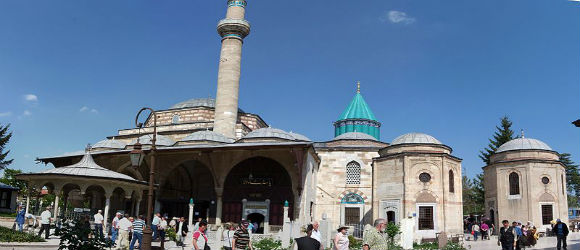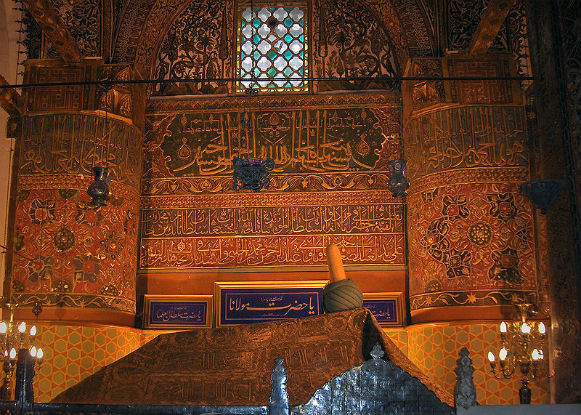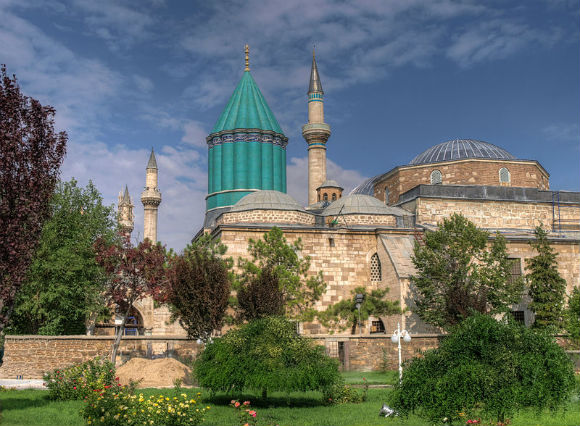The Mevlana Museum also known as the Green Mausoleum or Green Dome, is the original lodge of the Mevlevi Whirling Dervishes, a mystical Sufi Muslim group. It containes the tomb and shrine of the Mevlana, or Rumi, which remains an important place of pilgrimage.
History
Sultan ‘Ala’ al-Din Kayqubad, the Seljuk sultan who had invited Mevlana to Konya, offered his rose garden as a fitting place to bury Baha’ ud-Din Walad (or Bahaeddin Veled), the father of Mevlana, when he died in 1231. When Mevlana himself died on December 17, 1273, he was buried next to his father.
Mevlana’s successor Hüsamettin Çelebi built a mausoleum (Kubbe-i-Hadra) over the grave of his master. The Seljuk construction, under architect Behrettin Tebrizli, was finished in 1274. Gürcü Hatun, the wife of the Seljuk Emir Suleyman Pervane, and Emir Alameddin Kayser funded the construction.
The cylindrical drum of the of the dome originally rested on four pillars. The conical dome is covered with turquoise faience. Several sections were added until 1854. Selim I decorated the interior and performed the woodcarving of the catafalques.
A decree by Ataturk in September 1925 dissolved all Sufi brotherhoods in Turkey. On April 6, 1926, another decree ordered that the Mevlana mausoleum and dervish lodge be turned into a museum. The museum opened on March 2, 1927.
Special permission granted by the Turkish government in 1954 allowed the Mawlawi dervishes of Konya to perform their ritual dances for tourists for two weeks each year. Despite government opposition the order has continued to exist in Turkey as a religious body. The tomb of Rumi, although officially part of a museum, attracts a steady stream of pilgrims.
What to See
The dervish lodge (tekke) includes a semahane, where the ritual sema or whirling ceremony takes place, a sadirvan for ritual ablutions, a library, living and teaching quarters, and the mausoleum housing the tomb of Celaleddin Rumi, founder of the sect and later awarded the honorable title of Mevlana. His epitaph reads: “Do not seek our tombs on this earth – our tombs are in the hearts of the enlightened.”
The mausoleum room is highly ornamented with Islamic script and enameled reliefs, and contains the tombs of several of the more important figures of the dervish order. The main tomb enclosed behind a silver gate crafted in 1597 is that of Mevlana. The tomb of his father, Bahaeddin Veled, is upright and adjacent to his son’s, a position that signifies respect.
The adjoining room, or the semihane, is now a museum of Mevlana memorabilia displaying musical instruments and robes belonging to Mevlana, along with Selçuk and Ottoman objects like gold-engraved Korans from the 13th century. Among the fabulous ancient prayer rugs is the most valuable silk carpet in the world.
Mevlana Museum, Konya,




A shame we couldn't take pictures indoors but there was lots of history and culture to see here ! It as a hot sunny day but the indoor area was nice and cool. Tourists were here from many different countries to learn about Mevlana. A good idea to see it before going to see the whirling dervishes.
This is the home of the whirling dervishes museum and is a popular destination for buses full of tourists, and also contains a mosque containing ancient relics and a casket of hair from Mohammed, which the faithful gather around and offer prayers in supplication. The figures representating the dervishes are well represented, and the tourist moves from one cell-like room…
Depite its relatively large population, Konya wouldn't be very well-known outside of Turkey were it not for its asssociation with the life of famous Sufi poet Mevlana (Rumi.)
If you've come to this page, you probably already know that, so I won't ramble here about Rumi at all except to note that this museum is a worthy tribute.
It's interesting,…
As a Western, Christian visitor, I can truly say, if you do not find this museum inspirational, then perhaps you should go looking for your spirit.
if you are spiritual person, it's the best place in the world to be separated from any materialistic aspect of life and be alone with love and yourself
We went to Konya precisely to visit Rumi's Museum. The place includes his tomb, his writings, his clothes, tombs of his followers and artifacts from that era. It's an eye-opening experience to see his life's work. Cameras are not allowed inside so take it all in as much as you can!
The Mevlana Museum seems to be the number one tourist attraction in Konya. We didn't even know about it prior to arrival, as we were just planning to use Konya as an overnight stop to break up the long distance drive to Cappadocia. But we found that the Mevlana Museum was full of tourists, so we spent a couple hours…
Rumi is still widely revered with many crying women at his grave. No photos inside which is a shame. The details of the architecture and the tile work is second to none. A must see. Read Rumi first to appreciate
Very crowded but excellent. Would have liked more explanation in English.
You cannot take pictures inside, shoes must come off, and there are a lot of people. But it is all worth it. I am a big fan of Rumi so its natural I would appreciate the place. I ran into a lot of local Turkish women and although there was a language barrier the became very fond of me and…